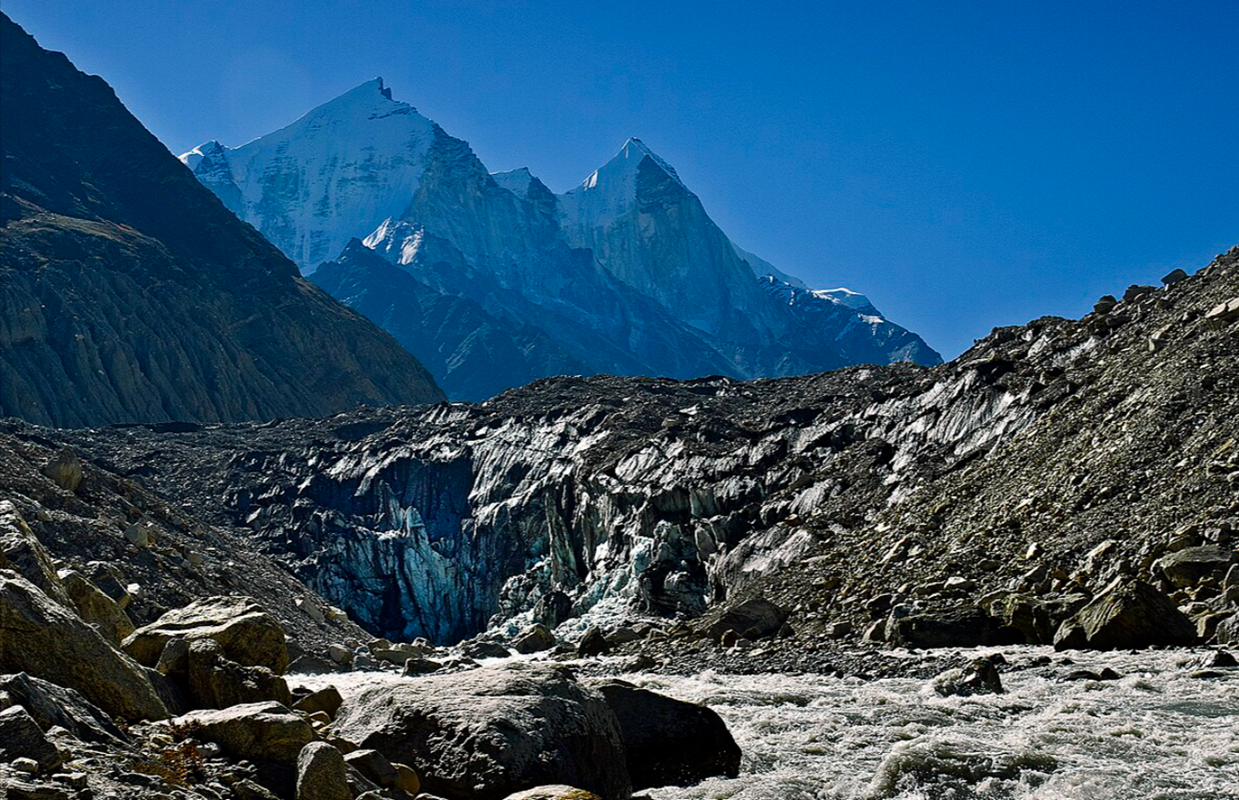Nestled in the heart of the Indian Himalayas, the Gangotri Glacier is one of the largest and most significant glaciers in the country. It holds immense geographical, environmental, and cultural importance. Stretching approximately 30 kilometers in length and 2 to 4 kilometers in width, the glacier lies in the Uttarkashi district of Uttarakhand, India. Most importantly, it is revered as the origin of the sacred river Ganga (Ganges), one of the holiest rivers in Hinduism. For centuries, this majestic glacier has attracted pilgrims, trekkers, geologists, and environmentalists alike.
Geographic Location and Physical Features
The Gangotri Glacier is situated in the Garhwal Himalayas, beginning at the Chaukhamba massif and extending up to Gaumukh—the snout of the glacier, which is considered the physical source of the river Bhagirathi, a primary tributary of the Ganga. The glacier lies at an altitude ranging from approximately 4,000 meters to over 7,000 meters above sea level.
This glacier system consists of a central main glacier and numerous tributary glaciers such as Raktvarn, Chaturangi, and Kirti. These glaciers are fed by snow and ice from several peaks, including Shivling (6,543 m), Thalay Sagar (6,904 m), Meru (6,660 m), and Bhagirathi peaks (I, II, and III).
Gaumukh: The Cow’s Mouth
The terminus of the Gangotri Glacier is known as Gaumukh, which literally means “cow’s mouth” in Hindi. The name comes from the natural rock formation at the glacier’s snout that resembles a cow’s mouth. It is from Gaumukh that the Bhagirathi River emerges, eventually joining the Alaknanda River at Devprayag to form the Ganga.
Gaumukh is not only a geographical landmark but also a highly sacred site for Hindu pilgrims. Devotees undertake a challenging 19-kilometer trek from the Gangotri Temple to Gaumukh to witness the sacred glacier and take a holy dip in its icy waters.
Religious and Cultural Significance
The Gangotri Glacier holds unparalleled religious importance. According to Hindu mythology, the river Ganga descended from heaven to Earth through the locks of Lord Shiva to cleanse the sins of humanity. The temple town of Gangotri, located about 19 kilometers downstream from the glacier, is one of the Char Dhams (four sacred pilgrimage sites in Uttarakhand).
Every year, thousands of devotees travel to Gangotri to offer prayers at the Gangotri Temple, which is believed to be the place where Goddess Ganga first descended on Earth. The journey to Gaumukh is often seen as an act of devotion and spiritual purification.
Environmental Importance
As one of the largest glaciers in the central Himalayas, Gangotri Glacier is a vital source of freshwater for millions of people in northern India. The glacier feeds the Ganga, which supports agriculture, industry, and domestic water supply across several states.
Furthermore, the glacier acts as a natural reservoir, storing snow and ice during the winter and releasing meltwater during the summer, thereby maintaining the flow of the Ganga even in dry seasons. This makes the glacier an essential component of the regional hydrological cycle.
Glacial Retreat and Climate Change
In recent decades, the Gangotri Glacier has been retreating at an alarming rate due to global warming and environmental degradation. Studies show that the glacier has retreated by over 1,500 meters in the last 70 years. The average annual rate of retreat has been approximately 15 to 20 meters in recent years.
Scientists attribute this retreat to rising temperatures, decreasing snowfall, and increased carbon emissions. The loss of glacial mass not only threatens the volume of water in the Ganga but also raises concerns about natural disasters such as flash floods and landslides in the Himalayan region.
One of the most notable disasters in recent memory was the 2013 Kedarnath flash floods, which were partly caused by glacial lake outburst floods (GLOFs). These events serve as a grim reminder of the delicate balance of the Himalayan ecosystem.
Trekking and Tourism
Despite the harsh terrain and high altitude, the Gangotri Glacier is a popular destination for trekkers and adventure enthusiasts. The trek to Gaumukh begins at Gangotri and passes through scenic alpine meadows, dense deodar forests, and steep rocky paths. The route offers breathtaking views of snow-covered peaks and pristine landscapes.
Permits from the forest department are required to enter the Gangotri National Park, where the glacier is located. The best time to undertake this trek is between May and October, avoiding the monsoon months of July and August.
For those with more experience, extended treks to Tapovan and Nandanvan offer even more stunning views of the Himalayas and access to advanced base camps for climbing peaks like Shivling and Bhagirathi.
Conservation Efforts
Recognizing the ecological and spiritual significance of the Gangotri Glacier, both government and non-governmental organizations have taken steps to conserve the region. The Gangotri National Park, established in 1989, aims to preserve the unique biodiversity of the area, which includes species like the snow leopard, Himalayan tahr, and musk deer.
Initiatives such as afforestation, regulated tourism, waste management, and awareness campaigns are being implemented to reduce human impact on the fragile environment. Scientific research stations have also been established to monitor glacial health and climatic changes.
However, more needs to be done to ensure the long-term survival of the glacier. International cooperation, sustainable development policies, and grassroots participation are essential to combating the effects of climate change on the Himalayas.
Conclusion
The Gangotri Glacier is more than just a block of ice nestled in the Himalayas—it is a living entity that nurtures the land and its people. Its waters have shaped civilizations, inspired devotion, and sustained millions. But now, this glacier faces the daunting threat of climate change, retreating year by year.
Protecting the Gangotri Glacier is not just an environmental issue; it is a cultural, spiritual, and existential imperative. Whether as pilgrims seeking spiritual solace, scientists studying climate change, or travelers marveling at nature’s beauty, we are all stakeholders in the future of this sacred glacier.

